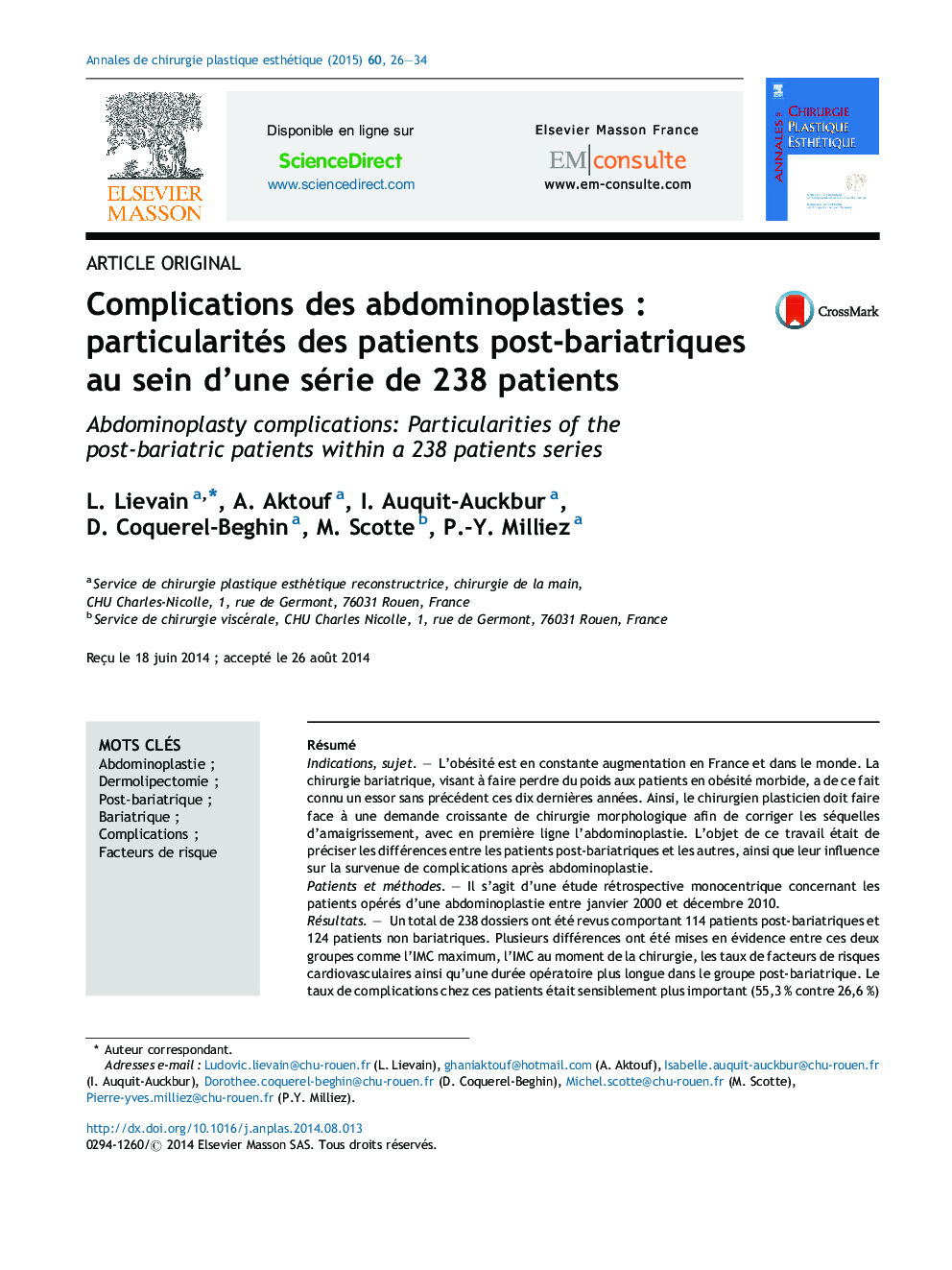| Article ID | Journal | Published Year | Pages | File Type |
|---|---|---|---|---|
| 3184575 | Annales de Chirurgie Plastique Esthétique | 2015 | 9 Pages |
RésuméIndications, sujetL’obésité est en constante augmentation en France et dans le monde. La chirurgie bariatrique, visant à faire perdre du poids aux patients en obésité morbide, a de ce fait connu un essor sans précédent ces dix dernières années. Ainsi, le chirurgien plasticien doit faire face à une demande croissante de chirurgie morphologique afin de corriger les séquelles d’amaigrissement, avec en première ligne l’abdominoplastie. L’objet de ce travail était de préciser les différences entre les patients post-bariatriques et les autres, ainsi que leur influence sur la survenue de complications après abdominoplastie.Patients et méthodesIl s’agit d’une étude rétrospective monocentrique concernant les patients opérés d’une abdominoplastie entre janvier 2000 et décembre 2010.RésultatsUn total de 238 dossiers ont été revus comportant 114 patients post-bariatriques et 124 patients non bariatriques. Plusieurs différences ont été mises en évidence entre ces deux groupes comme l’IMC maximum, l’IMC au moment de la chirurgie, les taux de facteurs de risques cardiovasculaires ainsi qu’une durée opératoire plus longue dans le groupe post-bariatrique. Le taux de complications chez ces patients était sensiblement plus important (55,3 % contre 26,6 %) avec essentiellement une majoration des problèmes de cicatrisation. Des facteurs de risques de complications ont été retrouvés comme un poids maximal important, l’obésité au moment de la chirurgie des séquelles, l’allongement de la durée opératoire et le système de drainage postopératoire.ConclusionsDe plus en plus fréquente, il apparaît que l’abdominoplastie chez les patients post-bariatriques nécessite une prise en charge spécifique du fait de particularités inhérentes à cette population.
SummaryBackgroundObesity is one of the health issues that is recently worldwide increasing, as well as in France. Variety of procedures of bariatric surgery have been developed over the past decade and are performed for morbid obesity hence. The demand of plastic surgery increased for body contouring and reshaping after dramatic weight loss, in which the abdominoplasty is considered as one of the most common procedures. The purpose of this study is to clarify the differences between the post-bariatric patients and others, and their influence on the occurrence of complications following abdominoplasty.Patients and methodsRetrospective study involving a group of post-abdominoplasty patients collected from the same center between January 2000 and December 2010.ResultsAmong 238 reviewed patients’ files ; 114 of them are post-bariatric patients, and 124 are non-bariatric patients. Several differences were found between these two groups of patients including the maximum BMI, BMI at the time of surgery, the rates of cardiovascular risk factors, and a longer operative time in the post-bariatric group. The complication rate in these patients was significantly higher (55.3% against 26.6%) with mainly healing problems. Major maximum weight, obesity at the time of surgery, long operative time and postoperative drainage system are all considered as risk factors, which carry high rate of complications.ConclusionIt appears that abdominoplasty in post-bariatric patients requires specific care because of particularities inherent in this population.
